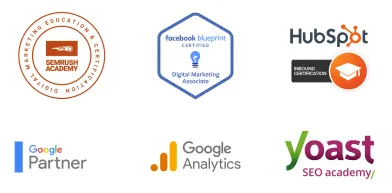TO LEARN IS TO GROW
Learning Center
We do our research and publish our results. Should probably call this the Growing Center.


Brand Development Strategies To Build Awareness For Your Business
Brand Development Strategies, Positioning, and Awareness
Companies with a solid brand generate 31% greater revenue growth and enjoy profit growth three times faster than their lesser-known competitors, even though brands don’t appear as “tangible” assets on the balance sheet.
While brands are commonly associated with logos, the truth is that they go beyond visual representations and witty taglines. In essence, they confer distinction on products and services, including those that are otherwise hard to tell apart (such as dishwashing soaps and orange juice).
Another misconception is that branding is primarily shaped by advertising and marketing. While it might be true on some rare occasions, it is the customer experience that describes the brand in the vast majority of cases.
The Fundamentals of Brand Strategy
Brand strategy is a long-term plan to address specific, predetermined goals that can be achieved through detailed steps. And because your brand defines your company’s purpose and target audience, it may need to evolve to reflect the ever-changing business landscape and consumer behavior.
Your brand development strategies must fulfill its core purpose despite the changing market landscape: Provide excellent customer experience, competitive edge, and long-term financial viability.
To reiterate, your brand is not just about your name, logo, slogan, color palette, and other visual representations. From a superficial standpoint, it appears like an ID “on display,” but in essence, it is more about ethereal elements like an experience, an expectation, or a promise.
To build an effective brand strategy, it should contain all the key elements described below:
Purpose
Anyone can make a promise. That’s why it is not your promise that will set you apart from your competitors, but your ability to execute it consistently.
Unlike promises, your purpose is more tangible. Hence, your brand development strategies should answer this fundamental question: Why does my business exist? To further separate yourself from the competition, you also have to identify what makes your product or service different from other companies within the same industry.
Some people think that money generation is the end all and be all of any business, but nothing could be further from the truth. While profit is the thing that sustains a company, it is the purpose that serves as the connecting bridge, the foundation, and the beacon that brings home the bacon.
Consistency
Consistency is what sets apart strong brands from mediocre ones. That is why when you go to McDonald’s and other fast food-chain giants, their foods taste the same whether you dine at their California City Boulevard branch or order from a drive-through Sunset Boulevard store.
Occasionally, consistency can make up for some of the product’s shortcomings; this is why some fast-food chains, despite their meals having less than stellar taste, have found a bit of success simply because their customers know what to expect. (This might prove that people are creatures of habit.)
Emotion
People buy with their emotions, not logic–at least in many cases. Because if they do buy with reason, the market will not be flooded with overpriced products with the same quality and materials as their cheaper alternatives.
When developing and marketing your brand, a good rule of thumb is to stoke people’s emotions. Make them think that if they choose your product, they will belong to an “elite” group, or perhaps someone who can make valuable contributions to a “cause.” (This explains the increasing number of companies going “green.”)
Furthermore, strive to build relationships with people, or from a business standpoint, your customers. As previous studies have shown, humans have “a basic psychological need to feel connected to others….and affection bonds from these relationships are a major part of human behavior” (Baumeister and Leary, 1995).
Flexibility
Your brand development strategies must evolve with the changing business landscape and consumer sentiment and behavior; this is particularly true during disruptive events like coronavirus pandemic, market crash, economic recession, among others.
However, having a flexible branding strategy doesn’t mean you lack consistency. Think of it this way: You must be consistent with your core business values, i.e., provide the best customer experience and give real solutions to their problems, while your marketing strategies can change depending on where your target audience “hangs out”–Are they in TikTok? Do they now prefer image-focused social sites like Pinterest and Instagram? Or do they like the exclusivity of Facebook Group?
When your old strategies don’t work anymore, don’t be afraid to create and try new ones. Whether it’s setting up a new website, introducing a new product, or improving old ones, you should constantly adapt to the ever-changing landscape lest you become history.
Employee Involvement
If your brand is cheerful and lively on social media platforms, it won’t make sense if your employees are dull and ill-tempered to your customers.
You want your customers to receive the same experience in every interaction with your brand.
Loyalty
Once you have established a customer base that supports your company and your brand, don’t take them for granted, just like many companies do. Instead of nurturing their current customers, they spend more time and money attracting new ones, even though studies have shown that it is 5-25 times more expensive acquiring new clients than retaining the existing ones.
Loyalty is a critical part of your brand development strategies. After all, you can turn happy customers into your ardent promoters or even social media influencers who can help you further expand your customer base without having to spend more on your marketing efforts. While they don’t expect monetary rewards–at least the vast majority of them–make sure that you continue nurturing them with discounts, promos, and free but valuable “stuff” like infographics, how-to blog posts, and video tutorials.
Competitive Awareness
Sun Tzu’s famous quote “know your enemy” has a solid business application, especially if you are operating in a cutthroat, saturated market. The goal is to know your competitors’ successes and their failures, why their customers patronize them, and where they fall short, allowing you to tap an important market segment that they are taking for granted.
Also, look at the companies struggling to stay afloat or already bit the dust (Nokia is a perfect example). Remember, it is better to learn from the mistakes of others than learn from them firsthand.
Importance of Brand Strategy for Positioning
Brand positioning is the process of creating a space for your brand in the minds of your target audience and existing customers, allowing your business to differentiate itself from the competition.
Also, it defines how people perceive your brand against other companies that also offer the same product or service. Consequently, it can justify your pricing based on the customer’s perceived value of your product.
Brand Strategy and Brand Awareness
Brand awareness promotes trust, and people only buy from companies they trust.
One way to drive brand awareness is to provide your target audience with free but valuable stuff like how-to blog posts, video tutorials, infographics, and printed materials bearing your company’s name or logo (t-shirt, pen, and other knick-knacks). You can also resort to social media contests, partner with other local businesses, and offer referral programs wherein the customer-cum-promoter gets some perks in exchange for promoting your product.
According to a recent study, 84% of people trust online reviews as much as their friends and family’s recommendations.
Other Things to Keep in Mind
When branding your company online, keep these key performance indicators in mind.
Quantitative Measurement
Direct Traffic – It is the result of people typing in your URL and directly visiting your website. It comes from individuals who are already aware of your brand.
Site Traffic Numbers – This number reflects your overall traffic. It gives you an idea of how much of the general internet population spends time with your brand.
Social Engagement – This measurement can refer to the number of followers, likes, comments, retweets, etc., your brand has. It also shows how many people interact with your brand.
Qualitative Measurement
Searching Google and setting up Google Alerts allows you to get an insight into your brand online.
Social listening – Keep track of the people who tag your brand, use your hashtags, and mention you in comments through social media management tools.
Running brand awareness surveys – Use surveys to get direct feedback from your audience.
A Final Word About Brand Development Strategies, Positioning, and Awareness
Branding is the best way to make sure that your business is unified when presenting your company to the world.
So please don’t hesitate to give us a call today!
Built for Growth. Backed by 25 Years of Trust.
For over two decades, LOJO has been a trusted partner to hundreds of businesses just like yours. Whether working directly with owners, managers, teams, or boards of directors, our goal remains the same: to be a reliable and results-driven asset to your business.
Over the years, we’ve carefully built a team of experts—each selected for their unique skills, strengths, and personalities. Our clients choose LOJO because they know we genuinely care about their success.
And after 25 years of helping businesses grow, we’re more committed than ever.



Built for Growth. Backed by 25 Years of Trust.
For over two decades, LOJO has been a trusted partner to hundreds of businesses just like yours. Whether working directly with owners, managers, teams, or boards of directors, our goal remains the same: to be a reliable and results-driven asset to your business.
Over the years, we’ve carefully built a team of experts—each selected for their unique skills, strengths, and personalities. Our clients choose LOJO because they know we genuinely care about their success.
And after 25 years of helping businesses grow, we’re more committed than ever.




Matthew Rogers, President
iProspect Check
After spending several months reviewing multiple proposals from several different companies we engaged LOJO to develop a new website that represents our company effectively. We worked initially with Stephen Platte who helped create the scope of the project. Stephen was knowledgeable and always followed up with me on time and as promised.
He "closed the deal" for LOJO with his professionalism, service orientation and easy going approach. Once we signed the contract we were introduced to Jay Kelly who would be the creative lead for LOJO. This was the most challenging part of the project for my company, as there was no shortage of ideas from our side. Jay managed the project flawlessly, and once we had all agreed to the design, Jay introduced us to Eric.
Eric Lay is one of the founders of LOJO. Eric took the design we had developed and brought it to life. We delivered content as quickly as he requested it. Eric kept the project on task and we responded by exceeding every deadline for content. In turn, once provided, literally not a day went by that Eric didn't add the content and take the next step. In just a few weeks we launched our new website. Eric is a pleasure to work with.
His positive attitude and consultative approach really enhanced the experience and made a big difference for us in the outcome of our project. We would welcome you to visit our website to take a look at the quality work of LOJO. We are very pleased with LOJO and look forward to working with them in the future as we pursue an aggressive SEO strategy."
After spending several months reviewing multiple proposals from several different companies we engaged LOJO to develop a new website that represents our company effectively. We worked initially with Stephen Platte who helped create the scope of the project. Stephen was knowledgeable and always followed up with me on time and as promised.
He "closed the deal" for LOJO with his professionalism, service orientation and easy going approach. Once we signed the contract we were introduced to Jay Kelly who would be the creative lead for LOJO. This was the most challenging part of the project for my company, as there was no shortage of ideas from our side. Jay managed the project flawlessly, and once we had all agreed to the design, Jay introduced us to Eric.
Eric Lay is one of the founders of LOJO. Eric took the design we had developed and brought it to life. We delivered content as quickly as he requested it. Eric kept the project on task and we responded by exceeding every deadline for content. In turn, once provided, literally not a day went by that Eric didn't add the content and take the next step. In just a few weeks we launched our new website. Eric is a pleasure to work with.
His positive attitude and consultative approach really enhanced the experience and made a big difference for us in the outcome of our project. We would welcome you to visit our website to take a look at the quality work of LOJO. We are very pleased with LOJO and look forward to working with them in the future as we pursue an aggressive SEO strategy."

Matthew Rogers, President
iProspect Check
The team at LOJO were wonderful to work with. They are well organized and very patient as we worked through our marketing strategy and developed a well thought out and clear action plan at a reasonable price. We will definitely be back for our future campaign needs."

Jon Crosby, Founder
Dazil

